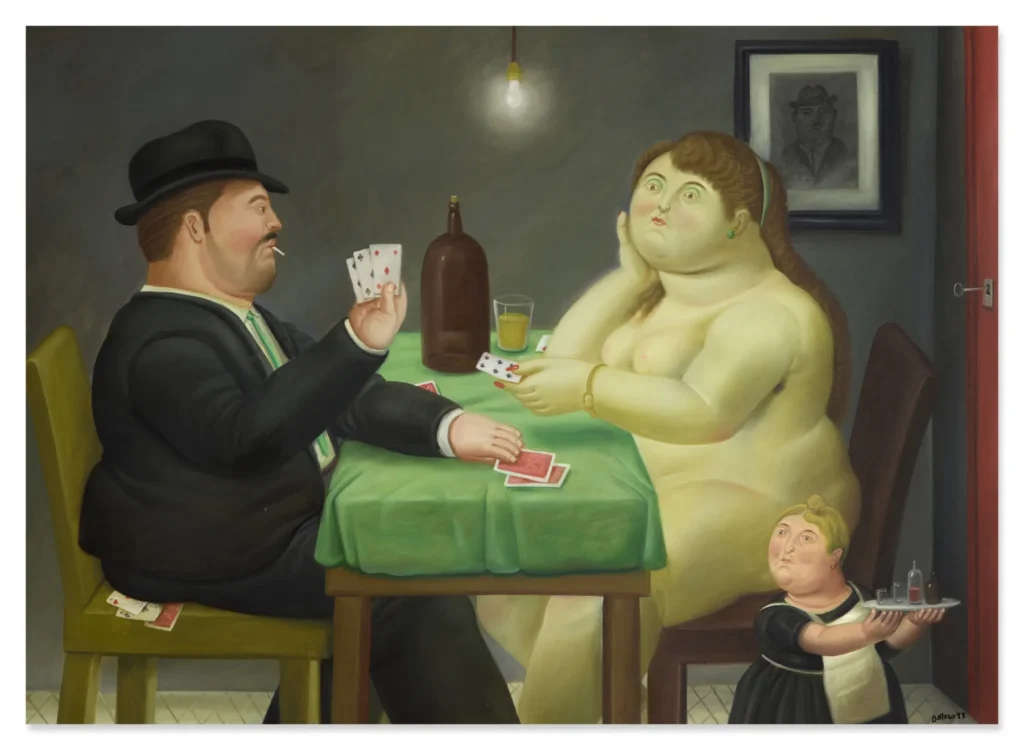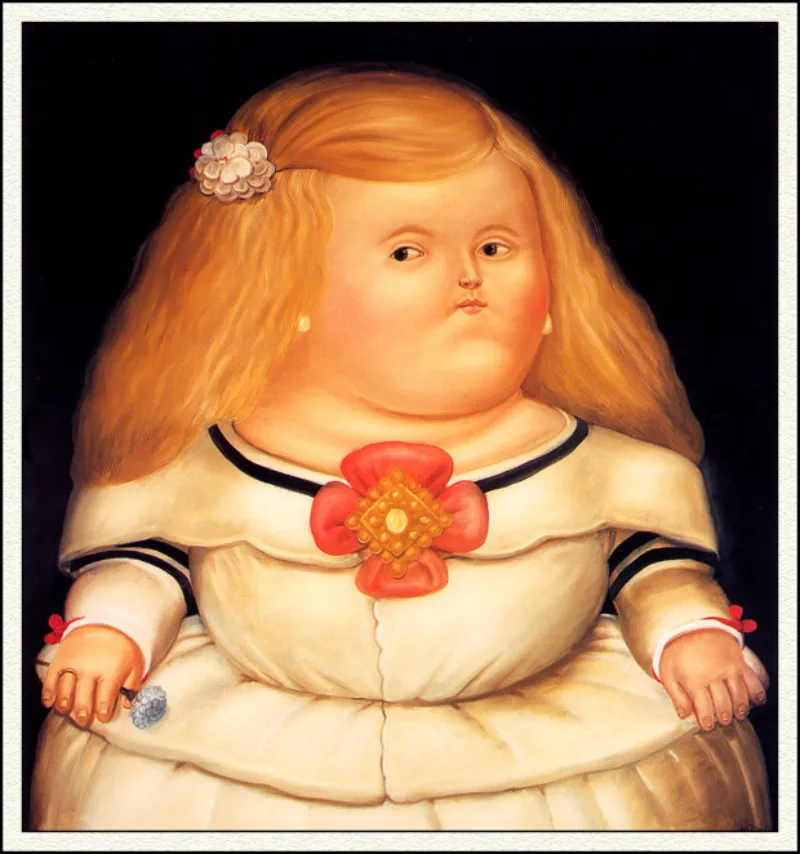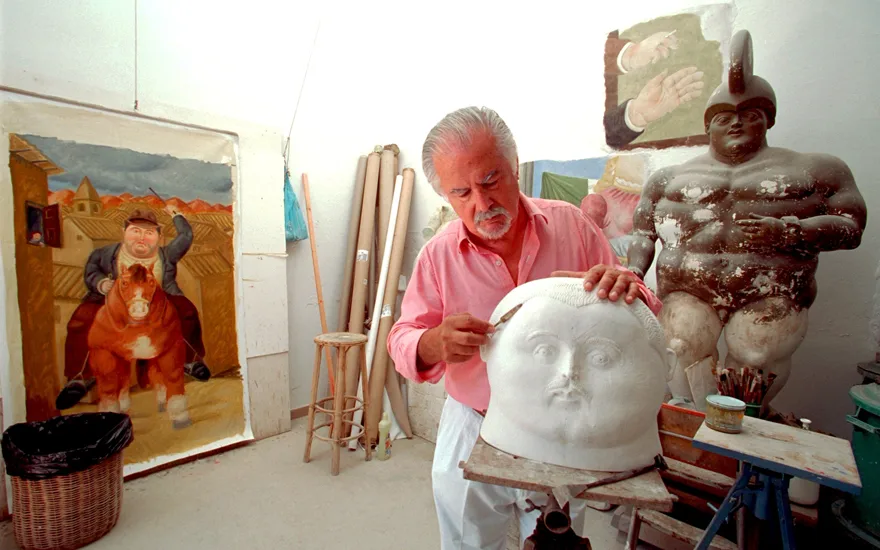Beyond the surface of rotund shapes lies a disciplined artist with a deep understanding of form, composition, and color.
This article explores Fernando Botero’s artistic style, provides a guide to the most famous Botero paintings, and offers insight into Botero’s best-known works, examining their relevance in the contemporary art world and U.S. market.
Fernando Botero’s artistic style: volume, elegance, and irony
At the heart of Fernando Botero’s artistic style is the manipulation of proportion. Rather than aiming for realism, Botero inflates forms (human bodies, animals, objects) giving them monumental presence on the canvas. This technique has often been misunderstood as mere whimsy or caricature. In reality, Boterismo is a calculated visual language that invites viewers to reconsider space, beauty, and power.
Key elements of Botero’s style include:
- Volumetric exaggeration: Figures are rounded and monumental, occupying the canvas with undeniable presence.
- Smooth, untextured surfaces: Faces and bodies appear polished, enhancing the classical, almost sculptural quality of the paintings.
- Balanced composition: Despite the inflated forms, every element is placed with precision. Botero often follows classical rules of symmetry and perspective.
- Warm, vibrant color palettes: Rich reds, deep greens, and glowing yellows create a sense of warmth and life, even when the themes are dark.

This unique style has positioned Fernando Botero as a cornerstone of modern Latin American painting, with a visual identity so strong that even those unfamiliar with his name recognize his work instantly.
Botero’s Best-Known Works: A guide to his most iconic paintings
Over his long career, Botero produced hundreds of paintings, and they stand out impactful. These best-known Botero works have appeared in major museums, auction catalogs, and retrospectives around the world.
Mona Lisa, Age Twelve (1959)
One of Botero’s earliest global successes, this painting reinterprets Leonardo da Vinci’s iconic portrait through the lens of Boterismo. The childlike subject, wide-faced and composed, reflects Botero’s interest in transforming art historical references into something wholly his own.
The Presidential Family (1967)
A satirical group portrait that critiques political elitism. The oversized bodies, stiff posture, and excessive formalism serve as a humorous yet biting commentary on Latin American power structures.
A Family (1989)
This domestic portrait is a perfect example of Botero’s ability to create both distance and intimacy. The figures are expressionless yet unified, embodying both order and absurdity.
Dancers (2002)
A celebration of movement and sensuality, this painting features a couple caught mid-step. The sweeping dresses and softly exaggerated bodies communicate elegance and joy, typical of Botero painting descriptions focused on love and festivity.
Death of Pablo Escobar (1999)
One of Botero’s most politically charged works. Despite the subject’s violence, Botero’s style imbues the scene with surreal serenity, inviting complex interpretations of justice and national trauma.
These works often top lists like “Fernando Botero paintings list” and appear frequently in searches related to “most famous Botero paintings.”
Themes in Fernando Botero’s Paintings: From the personal to the political
Botero’s paintings range across genres and themes, each treated with the same stylistic lens. His best-known categories include:
1. Portraits and Group Scenes
Whether religious figures, politicians, or everyday people, Botero’s portraits emphasize the individual as a universal symbol. Their formal poses and static expressions create a sense of solemnity that contrasts with their physical exuberance.
2. Nudes and Eroticism
Fernando Botero’s nudes, like Nude with Cat or Reclining Woman, have become icons of voluptuous sensuality. These works are frequently bought by collectors, often turning up in auctions that includes artworks like “Botero nude paintings” or “Botero female figures.”
3. Political Commentary
In the 2000s, Botero painted the Abu Ghraib series in response to reports of torture by U.S. forces. Though not commercially exhibited, they were shown in universities and museums, cementing his role as a socially engaged artist.
4. Reimagined Classics
Botero reinterprets masterpieces by Velázquez, Ingres, and others, placing them in his volumetric universe. These paintings are not parodies but reinterpretations; honest dialogues between modernity and tradition.

Each theme reflects a consistent worldview: beauty and critique coexist in the exaggerated form.
Collecting Botero: Demand and Value in the U.S. Market
The U.S. art market has long embraced his art. Fernando Botero’s paintings are widely collected, especially in Miami, New York, and Los Angeles, cities with strong Latin American cultural networks. His artworks are regularly part of Sotheby’s and Christie’s auctions, where they fetch strong prices and garner international attention.
Why U.S. collectors seek Botero:
- Visual appeal: His paintings are visually striking and timeless, resonating with both traditional and contemporary tastes.
- Cultural relevance: As Latin American culture continues to rise in visibility, Botero’s work serves as a powerful bridge.
- Institutional support: Museums such as the Museum of Latin American Art (MOLAA) and the Museum of Fine Arts, Houston have shown strong support for Botero’s exhibitions.
Popular trending topis in the art community like “collect Botero paintings” or “Botero paintings for sale” reflect the increasing demand for his works among new and seasoned collectors alike.
Botero Paintings vs Sculpture: Two mediums, one language
Although Fernando Botero is also a celebrated sculptor, his paintings offer an intimate encounter with his vision. While his bronze sculptures dominate public plazas, his painted works invite viewers into domestic, political, and personal spaces.
Both media share the same formal language: volume, symmetry, and calm, but painting allows for greater narrative nuance. For this reason, people often compare Botero sculpture vs painting, trying to understand which better captures his legacy.

Why Botero matters today.
In a world increasingly defined by speed, minimalism, and fragmentation, Fernando Botero’s art stands out for its timeless calm and sensuality. He offers a counterpoint to contemporary anxiety: an invitation to sit with excess, to appreciate beauty without irony, and to confront history with humor and grace.
Fernando Botero paintings offers insight into a practice that blends classical form with modern content. His work is both deeply personal and universally accessible—a rare combination in today’s art landscape.
Fernando Botero’s best-known works aren’t just about volume, they’re about vision. His mastery of form, color, and composition has produced some of the most iconic images in Latin American art. As U.S. interest in Latin American culture continues to grow, so too does the relevance of Fernando Botero’s artistic style.




